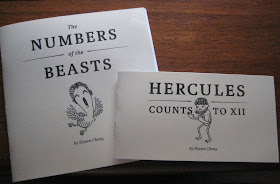When I approached the Center for Cartoon Studies table at SPX, my friend Robyn Chapman suggested that I get
Keny Widjaja to draw a demon for me, and I picked up what looked to be the last SPX copies of a couple of Keny's minis:

Of the two,
Tales of Rodentia is the more recent, and also the more polished-looking. It's the first chapter in what looks to be an epic about the conflict between small rodents and their predators in a world where these creatures talk, wear clothes, and use tools. (It reminds me a little bit of
Mouse Guard in this respect, though Widjaja's world seems more busy, and his concerns seem closer to social satire.) A village in Rodentia is under threat from predators, and a caravan of devotees of a central monotheistic (and possibly corrupt) church arrives to save the town.
There's a lot to like in this book. The cartooning is lively and loose, the world is expansively imagined, and the plot is complex without being difficult to follow. I'll be wanting to read further installments, for sure, though I have a few caveats and nits to pick.
First, as with the mini by Tyler Hutchinson I looked at yesterday, this comic looks a lot better online than it does on paper. There's a lot of Photoshop gray in Widjaja's
online version—and maybe some pencil shading, too—that gets muddy in halftone screens for xerox reproduction. If you click over to the online version and flip a few pages, you can compare that to this:

Although that's a two-page spread with some really interesting drawing in it, most of the work of the drawing gets lost either in the halftone grays or in the bold camouflage pattern of the trees in the "metapanel" background. It's hard to look at the four smaller panels on that page, really. (It's also hard to know what order to read them in, though that doesn't matter much. Still, extending the first panel past the page crease would have helped to indicate that the next panel is the one to the right.)
Look at what you miss by not being able to read those panels clearly:

Our travelers, escaping from a hive of massive white ants!

Cute critters ducking past the carcass orchids, noses held!
My other major qualm about this comic is about its lettering, which is all in a computer font that, while fairly attractive, doesn't do a great job imitating hand lettering, and—especially when there's a large block of it—starts to look more like "presentation text" than "comics speech." Also, because the art within the panels has so much softness (in those halftone grays I mentioned before), the hard, precise computer-lettering forms really stick out sometimes, and keep the speech balloons from seeming to be part of the same surface with the drawings.

On the other hand, if Widjaja is going to letter with the computer, there's really no excuse for him to have punctuation errors in the printed comic. Getting his apostrophes in the right place should be only a little more difficult than getting someone else to read the comic before it's printed.

But I don't want to make it seem like I didn't enjoy
Tales of Rodentia. It's just that I can see some of the signs that Widjaja is still learning and developing, as a cartoonist, and I hope that he'll pull some of these things together in the years to come.
Jester's Odyssey is an earlier comic, and doesn't have the same problems of translation to the printed page, because it's all done in solid, easy-to-photocopy black ink. It also seems to be a more personal comic in some ways, though the material is still firmly set in the swords-and-sorcery fantasy milieu.
As with
Tales of Rodentia, there's a lot of visual inventiveness and fun in this book.

Are those ogres in the first panel Charlie Brown and Linus?

It's interesting to see how much Widjaja's drawing style changed over the course of a single year.
Jester's Odyssey is looser, almost scribbly in places, and more energetic. (Also a bit harder to read, in places, because the scribbly lines obscure some of the forms of characters and objects.)

I'm not sure whether both of these stories will really see second chapters. Judging from his blog, Keny has moved on to another project, at least for the time being. And if I had to choose which one of these two stories I'd like to see more of, it'd be hard to pick. On the one hand,
Rodentia has a lot more plot momentum, and I really like looking at it (especially in its online version); on the other hand
Jester's Odyssey feels like it has more behind it, somehow—as if it might be capable of going to dark and poignant places that
Rodentia would have trouble finding.
Oh, and I think I mentioned that Keny drew a demon for my sketchbook at SPX ...

This doodle has me really looking forward to Keny's
Rangda comic.




















































